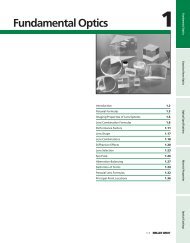Intel PXA250 and PXA210 Applications Processors
Intel PXA250 and PXA210 Applications Processors
Intel PXA250 and PXA210 Applications Processors
Create successful ePaper yourself
Turn your PDF publications into a flip-book with our unique Google optimized e-Paper software.
Contents<br />
Figures<br />
1-1 <strong>Applications</strong> Processor Block Diagram......................................................................................1-2<br />
1-2 <strong>PXA250</strong> <strong>Applications</strong> Processor..............................................................................................1-11<br />
1-3 <strong>PXA210</strong> <strong>Applications</strong> Processor..............................................................................................1-15<br />
2-1 General Memory Interface Configuration ..................................................................................2-2<br />
2-2 SDRAM Memory System Example............................................................................................2-4<br />
2-3 32-Bit Variable Latency I/O Read Timing (Burst-of-Four, One Wait Cycle Per Beat)..............2-10<br />
2-4 Expansion Card External Logic for a Two-Socket Configuration.............................................2-12<br />
2-5 Expansion Card External Logic for a One-Socket Configuration.............................................2-13<br />
2-6 Alternate Bus Master Mode .....................................................................................................2-15<br />
2-7 Variable Latency I/O ................................................................................................................2-16<br />
2-8 CS, CKE, DQM, CLK, MA minimum loading topology.............................................................2-17<br />
2-9 CS, CKE, DQM, CLK, MA Maximum Loading Topology .........................................................2-17<br />
2-10MD Minimum Loading Topology..............................................................................................2-17<br />
2-11MD maximum loading topology ...............................................................................................2-18<br />
3-1 Single Panel Monochrome Passive Display Typical Connection ..............................................3-3<br />
3-2 Passive Monochrome Single Panel Displays, Double-Pixel Data Typical Connection..............3-3<br />
3-3 Passive Monochrome Dual Panel Displays Typical Connection ...............................................3-4<br />
3-4 Passive Color Single Panel Displays Typical Connection .........................................................3-4<br />
3-5 Passive Color Dual Panel Displays Typical Connection............................................................3-5<br />
3-6 Active Color Display Typical Connection...................................................................................3-7<br />
4-1 Self Powered Device .................................................................................................................4-1<br />
5-1 <strong>Applications</strong> Processor MMC <strong>and</strong> SDCard Signal Connections................................................5-3<br />
5-2 <strong>Applications</strong> Processor MMC to SDCard Simplified Signal Connection....................................5-5<br />
6-1 AC97 connection .......................................................................................................................6-1<br />
7-1 Linear Technology DAC with I2C Interface ...............................................................................7-2<br />
7-2 Using an Analog Switch to Allow a Second CF Card ................................................................7-3<br />
7-3 I 2 C Pull-Ups <strong>and</strong> Pull-Downs.....................................................................................................7-3<br />
8-1 Power-On Reset Timing ..........................................................................................................8-12<br />
8-2 Hardware Reset Timing...........................................................................................................8-13<br />
8-3 GPIO Reset Timing .................................................................................................................8-13<br />
8-4 Sleep Mode Timing..................................................................................................................8-14<br />
8-5 Example Form Factor Reference Design Power System Design............................................8-22<br />
9-1 JTAG/Debug Port Wiring Diagram ............................................................................................9-1<br />
Tables<br />
1-1 Revision History.........................................................................................................................1-1<br />
1-2 Related Documentation .............................................................................................................1-1<br />
1-3 Signal Pin Descriptions..............................................................................................................1-4<br />
1-4 <strong>PXA250</strong> <strong>Applications</strong> Processor Pinout — Ballpad Number Order .........................................1-12<br />
1-5 <strong>PXA210</strong> <strong>Applications</strong> Processor Pinout — Ballpad Number Order .........................................1-16<br />
2-1 Memory Address Map ...............................................................................................................2-3<br />
2-2 SDRAM Memory Types Supported by the <strong>Applications</strong> Processor...........................................2-5<br />
2-3 Normal Mode Memory Address Mapping ..................................................................................2-6<br />
2-4 <strong>Applications</strong> Processor Compatibility Mode Address Line Mapping..........................................2-7<br />
2-5 Valid Booting Configurations Based on Package Type .............................................................2-8<br />
2-6 BOOT_SEL Definitions..............................................................................................................2-8<br />
vi<br />
<strong>PXA250</strong> <strong>and</strong> <strong>PXA210</strong> <strong>Applications</strong> <strong>Processors</strong> Design Guide
















